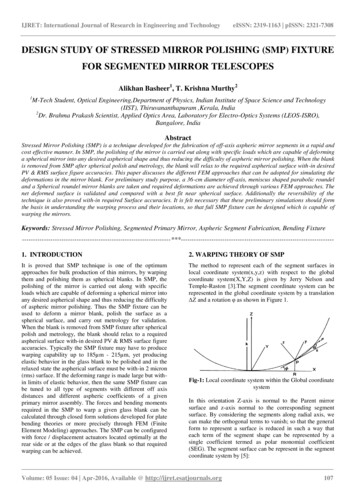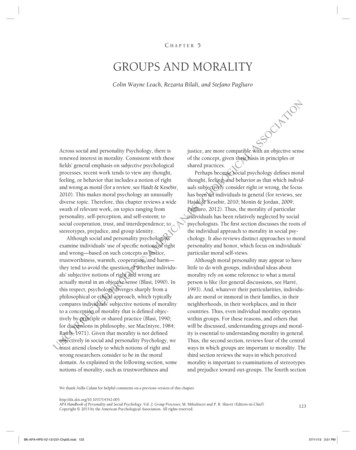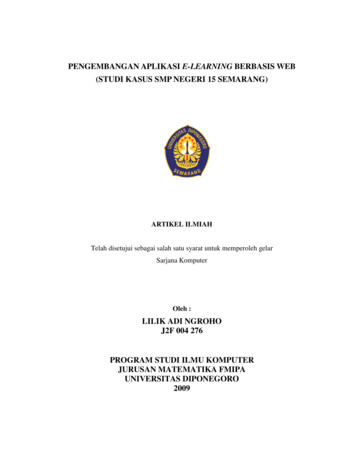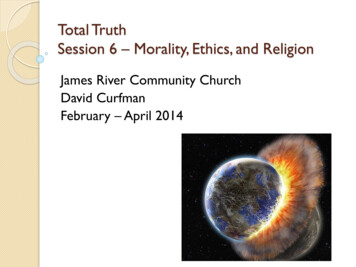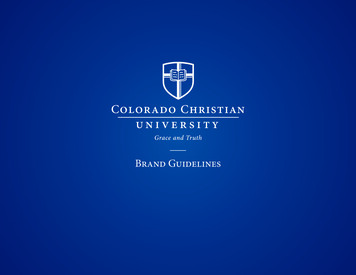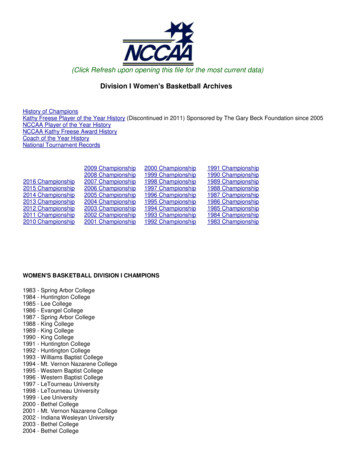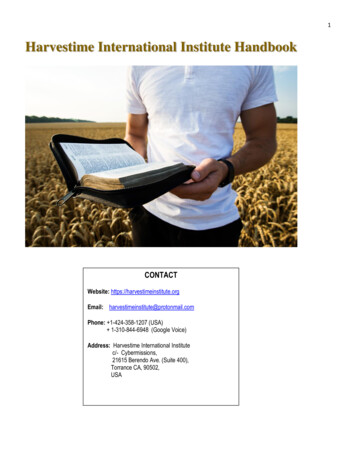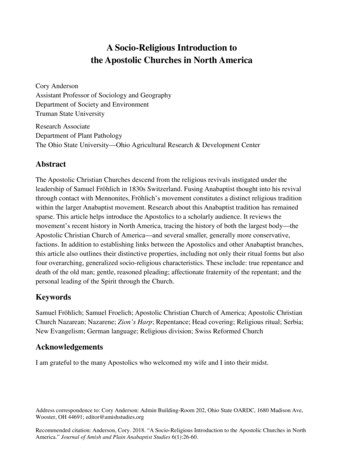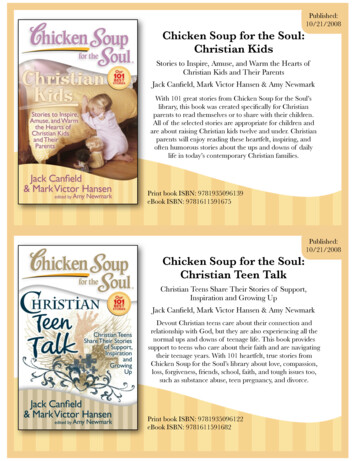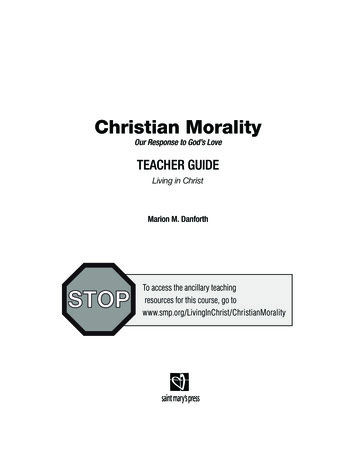
Transcription
Christian MoralityOur Response to God’s LoveTeacher GuideLiving in ChristMarion M. DanforthTo access the ancillary teachingresources for this course, go towww.smp.org/LivingInChrist/ChristianMorality
This book is dedicated to Br. Michel Bettigole, J. D. Childs,and Jason Curtis, who live and teach the life of Christ.I also dedicate this book to the faculty, staff, and studentsat Cardinal Gibbons High School, in Raleigh, North Carolina.The publishing team included Gloria Shahin, editorial director; Brian Singer-Towns,development editor. Prepress and manufacturing coordinated by the productiondepartments of Saint Mary’s Press.Cover Image: The Crosiers / Gene Plaisted, OSCCopyright 2012 by Saint Mary’s Press, Christian Brothers Publications, 702 TerraceHeights, Winona, MN 55987-1320, www.smp.org. All rights reserved. Permission isgranted to reproduce only the materials intended for distribution to the students. Noother part of this manual may be reproduced by any means without the written permission of the publisher.Printed in the United States of America1250ISBN 978-1-59982-098-9, PrintISBN 978-1-59982-454-3, KnoISBN 978-1-59982-119-1, Saint Mary’s Press Online Learning Environment
ContentsIntroducing the Living in Christ Series. . . . . . . . . . . . . . . . . . . . . . . . . . . . . . 7Unit 1: Foundations of Morality: God’s Plan. . . . . . . . . . . . . . . . . . . . . .Overview. . . . . . . . . . . . . . . . . . . . . . . . . . . . . . . . . . . . . . . . . . . . . . . . . . .Student Book Articles Addressed in this Unit:Article 1 – Created for Love and HappinessArticle 2 – The Freedom to ChooseArticle 3 – New Life in ChristArticle 4 – Justification and SanctificationArticle 5 – Eternal LawArticle 6 – Natural Moral LawArticle 7 – Law and the Original CovenantArticle 8 – Law and the New CovenantArticle 9 – Moral Law and the ChurchLearning Experiences. . . . . . . . . . . . . . . . . . . . . . . . . . . . . . . . . . . . . . . . .Handouts. . . . . . . . . . . . . . . . . . . . . . . . . . . . . . . . . . . . . . . . . . . . . . . . . . .Unit 2: Sin and Salvation. . . . . . . . . . . . . . . . . . . . . . . . . . . . . . . . . . . . . .Overview. . . . . . . . . . . . . . . . . . . . . . . . . . . . . . . . . . . . . . . . . . . . . . . . . . .Student Book Articles Addressed in this Unit:Article 10 – Sin in the Old TestamentArticle 11 – Sin in the New TestamentArticle 12 – Requirements for SinArticle 13 – Types of SinArticle 14 – Social SinLearning Experiences. . . . . . . . . . . . . . . . . . . . . . . . . . . . . . . . . . . . . . . . .Handouts. . . . . . . . . . . . . . . . . . . . . . . . . . . . . . . . . . . . . . . . . . . . . . . . . . .1616203966667085Unit 3: Honoring God . . . . . . . . . . . . . . . . . . . . . . . . . . . . . . . . . . . . . . . 106Overview. . . . . . . . . . . . . . . . . . . . . . . . . . . . . . . . . . . . . . . . . . . . . . . . . . 106Student Book Articles Addressed in this Unit:Article 15 – Living the First CommandmentArticle 16 – Idolatry, Ancient and ModernArticle 17 – Other Sins against the First CommandmentArticle 18 – Reverence, Responding to the Sacredness of GodArticle 19 – Keeping Sacred CommitmentsArticle 20 – Other Sins against the Second CommandmentArticle 21 – Observing the SabbathArticle 22 – The Sabbath and Sunday: A Short HistoryArticle 23 – Keeping Sunday HolyLearning Experiences. . . . . . . . . . . . . . . . . . . . . . . . . . . . . . . . . . . . . . . . 110Handouts. . . . . . . . . . . . . . . . . . . . . . . . . . . . . . . . . . . . . . . . . . . . . . . . . . 123
Unit 4: Obedience and Truth. . . . . . . . . . . . . . . . . . . . . . . . . . . . . . . . . .Overview. . . . . . . . . . . . . . . . . . . . . . . . . . . . . . . . . . . . . . . . . . . . . . . . . .Student Book Articles Addressed in this Unit:Article 24 – The Importance of Families in God’s PlanArticle 25 – Parent and Child ResponsibilitiesArticle 26 – Respect for Public LifeArticle 27 – Faithful CitizenshipArticle 28 – Honesty, the Key to Being RealArticle 29 – Becoming a Person of IntegrityArticle 30 – Other Sins against HonestyArticle 31 – Calling Society to IntegrityLearning Experiences. . . . . . . . . . . . . . . . . . . . . . . . . . . . . . . . . . . . . . . .Handouts. . . . . . . . . . . . . . . . . . . . . . . . . . . . . . . . . . . . . . . . . . . . . . . . . .142142Unit 5: Living Justly. . . . . . . . . . . . . . . . . . . . . . . . . . . . . . . . . . . . . . . . .Overview. . . . . . . . . . . . . . . . . . . . . . . . . . . . . . . . . . . . . . . . . . . . . . . . . .Student Book Articles Addressed in this Unit:Article 32 – The Moral Law and Material PossessionsArticle 33 – Called to Be JustArticle 34 – Calling Society to JusticeArticle 35 – Envy and GreedArticle 36 – Live Simply So Others May Simply LiveLearning Experiences. . . . . . . . . . . . . . . . . . . . . . . . . . . . . . . . . . . . . . . .Handouts. . . . . . . . . . . . . . . . . . . . . . . . . . . . . . . . . . . . . . . . . . . . . . . . . .182182146164186204Unit 6: Respecting Life . . . . . . . . . . . . . . . . . . . . . . . . . . . . . . . . . . . . . .Overview. . . . . . . . . . . . . . . . . . . . . . . . . . . . . . . . . . . . . . . . . . . . . . . . . .Student Book Articles Addressed in this Unit:Article 37 – Life, God’s Greatest GiftArticle 38 – Beginning-of-Life IssuesArticle 39 – End-of-Life IssuesArticle 40 – Called to Be PeacemakersArticle 41 – Personal HealthLearning Experiences. . . . . . . . . . . . . . . . . . . . . . . . . . . . . . . . . . . . . . . .Handouts. . . . . . . . . . . . . . . . . . . . . . . . . . . . . . . . . . . . . . . . . . . . . . . . . .224224Unit 7: Respecting Sexuality . . . . . . . . . . . . . . . . . . . . . . . . . . . . . . . . .Overview. . . . . . . . . . . . . . . . . . . . . . . . . . . . . . . . . . . . . . . . . . . . . . . . . .Student Book Articles Addressed in this Unit:Article 42 – Sexuality, Sharing in God’s Life-Giving PowerArticle 43 – Chastity, the Key to Sexual IntegrityArticle 44 – Sins against ChastityArticle 45 – The Christian Vision of Marriage and SexualityArticle 46 – Sins against the Dignity of Sexuality within MarriageLearning Experiences. . . . . . . . . . . . . . . . . . . . . . . . . . . . . . . . . . . . . . . .Handouts. . . . . . . . . . . . . . . . . . . . . . . . . . . . . . . . . . . . . . . . . . . . . . . . . .268268228246273288
Unit 8: Making Moral Choices. . . . . . . . . . . . . . . . . . . . . . . . . . . . . . . . .Overview. . . . . . . . . . . . . . . . . . . . . . . . . . . . . . . . . . . . . . . . . . . . . . . . . .Student Book Articles Addressed in this Unit:Article 47 – Called to Be HolyArticle 48 – GraceArticle 49 – The Cardinal VirtuesArticle 50 – The Theological VirtuesArticle 51 – The SacramentsArticle 52 – The Role of ConscienceArticle 53 – The Gospel Call to ForgivenessArticle 54 – Seeking Forgiveness and ReconciliationArticle 55 – Granting ForgivenessLearning Experiences. . . . . . . . . . . . . . . . . . . . . . . . . . . . . . . . . . . . . . . .Handouts. . . . . . . . . . . . . . . . . . . . . . . . . . . . . . . . . . . . . . . . . . . . . . . . . .316316321337Appendix 1: Additional Resource. . . . . . . . . . . . . . . . . . . . . . . . . . . . . . . . 360Appendix 2: Student Book/Teacher Guide Correlation . . . . . . . . . . . . . . . 362Acknowledgments. . . . . . . . . . . . . . . . . . . . . . . . . . . . . . . . . . . . . . . . . . . 366
Introducing the Living inChrist SeriesChristian Morality: Our Response to God’s Love is the second-semestereleventh-grade course in the Living in Christ series.Saint Mary’s Press developed the Living in Christ series in response tothe needs of important stakeholders in the catechesis process. The coursesfollow the sequence and contain the material from the USCCB’s CurriculumFramework. Each course also contains other material in the student book andteacher guide that students should know, understand, and be able to carryout. Each course responds to the varied needs that teachers have expressed,especially about limited time and the range of catechizing the young people in ahigh school religion class have had, offering wisdom from “secular” educationalmethods that can address both time limits and diversity in the classroom.With the Living in Christ series, Catholic high school students will understand foundational concepts about the Bible, Jesus Christ as a member of theTrinity, the Paschal Mystery, the Church, the Sacraments, and morality. Theywill also have skills to learn more about their faith by studying Scripture, readingprimary theological sources, consulting the Catholic faith community, doing selfreflection, and having conversations with their peers. With your guidance yourgraduates will possess a lived faith as they move into their future.The Living in Christ SeriesThe Living in Christ series has a different look and feel from traditional highschool theology textbooks and teaching manuals. The teacher guide, rather than the student book, provides the scopeand sequence for the course. Teaching with the student book is morelike teaching with The Catholic Faith Handbook for Youth (Saint Mary’sPress, 2008) than a textbook. The sequence of a textbook is importantbecause the content builds on what has come before. A handbook providesmaterial in a sensible order, but because the content does not rely on whathas come before in quite the same way, the material can be presented inseveral different sequences. The teacher guide provides you with ideas about how to teach notonly with the student book but also with the Bible, resources onthe Saint Mary’s Press Web site (smp.org/LivinginChrist), and otherresources found on the Internet. The teacher guide works as a command center for the course, providing ways for you to teach key concepts tothe students by bringing in a wide variety of resources.7
8Christian Morality: Our Response to God’s Love The Living in Christ series invites you as teacher to develop yourabilities to facilitate learning. This series asks you to become an expertabout your own students, discern how they learn best, and then lead themto understand main concepts in a way that speaks to their lived experiences and the issues of the day. The Living in Christ series invites the students to be more engaged intheir own learning. This series asks the students to take charge of theirlearning process and to practice what it will mean to be adult Catholics whomust translate scriptural and Church teaching into their real world.These changes will enable the students to consider the most important concepts in the course at a deeper level.The Series Web Site: smp.org/LivinginChristIn addition to the teacher guide and student book, the Living in Christ seriesprovides an extensive collection of digital resources for each course to assistyou in guiding the learning of your students. The digital resources are sorted onthe Web site by course and unit. For each unit in a course, you will find the following resources at smp.org/LivinginChrist: Handouts All handouts for a unit are provided in multiple digital formats,including Word and rich text formats that you can revise. Method articles Method articles explain teaching methods introduced in aunit that might be unfamiliar to some teachers. Theology articles Theology articles provide an in-depth exploration ofkey theological concepts presented in a unit to assist you in explaining theconcept and responding to student questions. PowerPoint presentations Student learning in each unit is enhanced withPowerPoint presentations. Beyond simply repeating student book content,these PowerPoint presentations engage students through reflection anddiscussion. All of the Living in Christ PowerPoint presentations are in aformat that allows you to revise them. Useful links Links to other resources are provided so you can enhanceyour students’ learning with additional resources. The links direct yourstudents to Web sites you can trust, and are continually checked for appropriateness and to ensure that they are active.
Introducing the Living in Christ SeriesAt smp.org/LivinginChrist you will also have access to an online test bank,which provides hundreds of questions for each course, beyond what is providedin the units. You can use test questions as they are presented or modify themfor your students’ learning needs.Introducing Christian Morality:Our Response to God’s LoveThis course leads the students toward a deeper understanding of God’s Lawrevealed to us through reason and Revelation. The course explores how Christ’slife and teaching is the fulfillment of the Old Law summarized in the Ten Commandments. Thus the content of the course is informed by the moral law in theOld Testament, by Christ’s moral teaching in the Gospels, and by the moralteaching of the Church as it applies to what God has revealed to our contemporary moral questions. The New Law of Christ calls us to go beyond keepingmoral minimums and to love God, neighbor, and self with all our being. We canonly do this empowered by God’s grace. In the end, Christian morality is aboutresponding to God’s love by living in full communion with God and others.The course has eight units centered on eight important questions or concepts about Christian morality. Each unit builds on the knowledge, skills, andunderstanding of the previous one. Within each unit the knowledge, skills, andunderstanding also build as it progresses. The eight units are as follows: Unit 1: Foundations of Morality: God’s Plan Unit 2: Sin and Salvation Unit 3: Honoring God Unit 4: Obedience and Truth Unit 5: Living Justly Unit 6: Respecting Life Unit 7: Respecting Sexuality Unit 8: Making Moral Choices9
10Christian Morality: Our Response to God’s LoveThe Structure of Each Unitin This Teacher GuideThis teacher guide offers the teacher one path through each unit, referring thestudents to the student book, the Bible, resources on the Saint Mary’s PressWeb site (smp.org/LivinginChrist), and other Internet resources.The path for each unit has the goal of leading all the students to comprehend four “understandings” with the related knowledge and skills. This curriculum model assumes that you will adjust your teaching according to the needsand capabilities of the students in your class. You do not have to complete everylearning experience provided, and we hope you substitute your own ideas forthose in the guide when needed.Each unit has three basic parts: the Overview, the Learning Experiences,and handouts.OverviewThe Overview is a snapshot of the whole unit. It provides the followinginformation: the concepts the students should understand by the end of the unit the questions the students should be able to answer by the end of the unit a brief description of the summary assessments (final performance tasks)offered, which will show that the students understand the most importantconcepts a list of articles from the student book covered in the unit a summary of the steps in the Learning Experiences section (Each step inthe unit builds on the one before but must be adjusted to fit your scheduleand the needs of the students. The use of steps is more flexible than is astructure based on 60-minute periods, for example.) a list of background material on content and methods that can be found onthe Saint Mary’s Press Web site (smp.org/LivinginChrist) a list of Scripture passages used a list of vocabulary that comes from the student book and from the learningexperiences in the teacher guide
Introducing the Living in Christ SeriesLearning ExperiencesThe instruction and learning occur in this section. Each unit contains a similarprocess for instruction.Preassess Student Knowledge of the ConceptsEach unit opens with one or more options for preassessing what the studentsalready know about a topic. It is useful to know this information as you prepareto present new material.Preassessing the students’ knowledge can help you to determine how touse your time effectively throughout the unit. It is not worth your time to teachthe students what they already know or to teach above their heads. Studentslearn most effectively when new concepts build on what they already know.More often, you have a mixed group knowledge-wise, which is good, becausethe students can help one another.Unit 1 offers a more comprehensive questionnaire to help you see wherethe students are coming from religiously and in terms of knowledge and belief.This preassessment will help you to make choices throughout the unit. Basedon what you learn in your preassessment in unit 1, you may decide to spendmore or less time on given topics.Present the Final Performance Tasks to the StudentsA final performance task is a type of summary assessment, which means thatit is a means of determining what the students understand, know, and can doafter a period of instruction such as a unit. (The unit test is also a summaryassessment.)In addition to providing a unit test, we encourage you to assess (determine) student understanding of the four most important concepts in each unitby assigning one of the short projects called final performance tasks. Throughthese projects the students can demonstrate their understanding of the mainconcepts. This assignment allows you to have another snapshot of what thestudents understand.For example, the four understandings for unit 3 are: The First Commandment calls people to put their faith and hope in Godalone and love him above all other things. In the New Law, Jesus expands our understanding of the First Commandment so it is clear that putting our faith in anything other than God for oursalvation and ultimate happiness is a form of idolatry. The Second Commandment calls people to honor God in every thought,word, and deed and to have reverence for everything that is holy. The Third Commandment is a call to keep Sundays holy through prayer,reception of the Eucharist, relaxation, and works of charity.11
12Christian Morality: Our Response to God’s LoveThe handout “Final Performance Task Options for Unit 3” (Document #:TX001824) in the teacher guide outlines the assignment options. Note that forall the options, the students must show their understanding of these concepts.The first final performance task option has the students create a prayer serviceusing the themes of love, reverence, and honor for God. The second asks themto create an original work of art that depicts these themes. The third asks themto write a creative dialogue between the voice of moral conscience and thevoice of temptation that addresses the key understandings for the unit. A traditional unit test is also provided.We suggest that you explain the performance task options early in the unitso the students can focus on the knowledge and skills they can use for the finalperformance task they choose. This also helps to decrease the number of “Arewe learning anything today?” or “Why do we have to learn this?” questions bygiving the students the big picture of where they are headed and how they willget there.Provide Learning Experiences for the Students toDeepen Their Understanding of the Main ConceptsThis teacher guide uses the term learning experiences rather than activitiesto emphasize that much of what goes on in the classroom should contributeto student learning, such as explaining assignments; presenting new material;asking the students to work individually, in pairs, or in groups; testing the students; and asking them to present material to their peers.Each step in the teacher guide leads the students toward deeper understanding of the four key understandings of a unit. At times learning experiencesare grouped into a single step because they work toward the same goal. Atother times a step includes only one learning experience. If you have a betterway of achieving a step goal, by all means use it. However, if new vocabularyor content is introduced in a step you have chosen to skip, you may want to goover that material in some way, or remove that material from the unit test.Throughout the steps, references are made to student book articles,resources at smp.org/LivinginChrist, and other Internet resources. Often theteacher guide addresses the content in the student book early in the unit andthen asks the students to uncover a deeper meaning with various learning experiences throughout. When applicable the book refers to smp.org/LivinginChristfor resources at your fingertips.The goal of this course is for the students to gain a deeper understandingof the material. But what is understanding? The understanding we want thestudents to gain is multifaceted. Understanding encompasses several of the“facets of understanding,” used by Jay McTighe and Grant Wiggins in their bookUnderstanding by Design:
Introducing the Living in Christ SeriesWe have developed a multifaceted view of what makes upa mature understanding, a six-sided view of the concept.When we truly understand weExplainInterpretApplyPerceiveEmpathizeReflectCan explain—via generalizations or principles,providing justified and systematic accounts ofphenomena, facts, and data; make insightfulconnections and provide illuminating examples orillustrations.Can interpret—tell meaningful stories; offer apttranslations; provide a revealing or personal historicaldimension to ideas and events; make the object ofunderstanding personal or accessible throughimages, anecdotes, analogies, and models.Can apply—effectively use and adapt what we know indiverse and real contexts—we can “do” the subject.Have perspective—see and hear points of viewthrough critical eyes and ears; see the big picture.Can empathize—find value in what others might findodd, alien, or implausible; perceive sensitively on thebasis of prior direct experience.Have self-knowledge—show metacognitiveawareness; perceive the personal style, prejudices,projections, and habits of mind that both shape andimpede our own understanding; are aware of what wedo not understand; reflect on the meaning of learningand experience.(P. 84)Note that Saint Mary’s Press has created icons for each facetof understanding. When a majority of facets are present, therewill be an “understand” icon. When relevant, all facets ofunderstanding should be addressed in each unit. If you areused to Bloom’s Taxonomy, see smp.org/LivinginChrist for a comparison ofboth models of understanding and learning.Understand13
14Christian Morality: Our Response to God’s LoveProvide a Day or Partial Day for the Students to Workon the Final Performance TasksThis guide encourages you to give the students time in class to work on theirfinal performance tasks if you have assigned them. You do not, however, haveto wait until the end of the unit. Not only does this day give the students timeto work in groups if needed or to do some research, but it also gives you theopportunity to identify any students who may be having trouble with the assignment and allows you to work with them during class time.Give the Students a Tool to Help Them Reflecton Their LearningThe handout “Learning about Learning” (Document #: TX001159; see Appendix)is a generic way to help the students think about what they have learned duringthe entire unit. This process, whether done this way or in another fashion, isvaluable for several reasons: The students do not get much time to reflect while they are moving througheach unit. Looking over the unit helps them to make connections, revisitany “aha!” moments, and identify which concepts remain difficult for them tounderstand. We give students a gift when we help them learn how they learn best.Insights such as “I didn’t get it until we saw the video” or “Putting togetherthe presentation required that I really knew my stuff” can be applied to allthe disciplines they are studying.Feel free to have the students discuss the handout questions in pairs attimes for variety.HandoutsAll the handouts in the teacher guide, as well as the unit tests, are available onthe Saint Mary’s Press Web site at smp.org/LivinginChrist, as PDFs, as Worddocuments, or in rich text format (RTFs), for downloading, customizing, andprinting. The handouts found at the end of each unit in this guide are simply forteacher reference.AppendixThe teacher guide has one appendix, which consists of a handout that is usedin each unit. The handout is also available at smp.org/LivinginChrist for downloading, customizing, and printing.
Introducing the Living in Christ SeriesThank YouWe thank you for putting your confidence in us by adopting the Living in Christseries. Our goal is to graduate students who are in a relationship with JesusChrist, are religiously literate, and understand their faith in terms of their reallives.Please contact us and let us know how we are doing. We are eager toimprove this curriculum, and we value your knowledge and expertise. You maye-mail us at LivinginChrist@smp.org to offer your feedback.15
Unit 1Foundations ofMorality: God’s PlanOverviewThis unit addresses foundational concepts in the study of Christian morality.These concepts include God’s plan for humanity, the significance of moral law,the vision of a new life in Christ based in the Beatitudes, and the role of Churchin helping us to be imitators of Christ. Through diverse learning experiences, thestudents will deepen their understanding of these foundational concepts and ofthe language the Church uses to express them.Key Understandings and QuestionsUpon completing this unit, the students will have a deeper understanding of thefollowing key concepts: Christian morality is rooted in God’s plan for humanity: human beings werecreated for communion with God, leading to true love and happiness. Obeying God’s Eternal Law is the path to true happiness; it is made knownthrough human intellect and Divine Revelation. God’s plan for how human beings are to live is fully revealed in the life andteachings of Jesus Christ. The Church assists its members in moral living through the teaching of theMagisterium, the Sacraments, and the Church’s law.Upon completing the unit, the students will have answered the followingquestions: How is Christian morality related to the divine gifts of intellect and free will? How can people come to know God’s Eternal Law? How does living the Beatitudes influence my daily actions? What is the role of the Catholic Church in the moral life of its members?How Will You Know the Students Understand?The following resources will help you to assess the students’ understanding of thekey concepts covered in this unit: handout “Final Performance Task Options for Unit 1” (Document #: TX001790) handout “Rubric for Final Performance Tasks for Unit 1” (Document #:TX001791) handout “Unit 1 Test” (Document #: TX001802)16
17Unit 1Foundations of Morality: God’s PlanStudent Book ArticlesThis unit draws on articles from Christian Morality: Our Response to God’sLove student book and incorporates them into the unit instruction. Wheneverthe teaching steps for the unit require the students to refer to or read an articlefrom the student book, the following symbol appears in the margin:. Thearticles covered in the unit are from “Section 1: Foundational Principles forChristian Morality,” and are as follows: “Created for Love and Happiness” (article 1, pp. 10–13) “The Freedom to Choose” (article 2, pp. 13–17) “New Life in Christ” (article 3, pp. 18–22) “Justification and Sanctification” (article 4, pp. 22–26) “Eternal Law” (article 5, pp. 29–31) “Natural Moral Law” (article 6, pp. 32–35) “Law and the Original Covenant” (article 7, pp. 36–40) “Law and the New Covenant (article 8, pp. 40–45) “Moral Law and the Church” (article 9, pp. 45–50)The Suggested Path to UnderstandingThis unit in the teacher guide provides you with one learning path to take withthe students, enabling them to begin their study of the foundations of morality. Itis not necessary to use all the learning experiences, but if you substitute othermaterial from this course or your own material for some of the material offeredhere, check to see that you have covered all relevant facets of understandingand that you have not missed knowledge or skills required in later units.ExplainStep 1: Preassess what the students already know about theUnderstandStep 2: Follow this assessment by presenting to the students thefoundations of morality to provide the students with feedback and toassist you in identifying points of emphasis in the unit of study.handouts “Final Performance Task Options for Unit 1” (Document #:TX001790) and “Rubric for Final Performance Tasks for Unit 1” (Document #: TX001791).ExplainStep 3: Build on the students’ initial understanding of God’s plan forApplyStep 4: Create still-life poses depicting how we might live out themorality by reinforcing that in God’s plan human beings were createdfor communion with God, leading to true love and happiness.New Law revealed in the Beatitudes.
18Christian Morality: Our Response to God’s LovePerceiveStep 5: Facilitate a discussion on the New Law revealed by ChristExplainStep 6: Reinforce key glossary terms found in articles 1, 2, 3, and 4as the path to ultimate love and happiness, using the results of astudent survey.of the student text by giving a quiz.EmpathizeStep 7: Use a reflective journaling exercise to examine the gift ofInterpretStep 8: Investigate the relationship between eternal, moral, andfreedom as a foundation for morality.natural law using true and false statements.ApplyStep 9: Create a visual representation of the relationship betweenApplyStep 10: Identify the moral values in the letters of the New Tes
moral minimums and to love God, neighbor, and self with all our being. We can only do this empowered by God’s grace. In the end, Christian morality is about responding to God’s love by living in full communion with God and others. The course has eight units centered on eight important question

